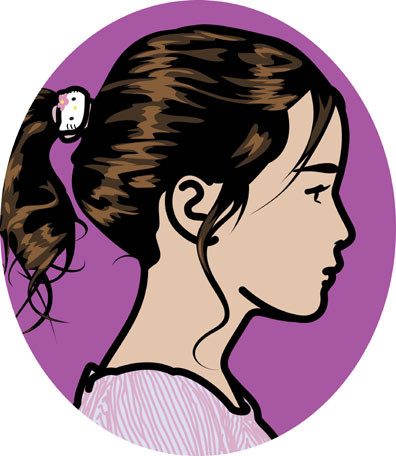Julian Opie
02 Jul - 06 Sep 2008
JULIAN OPIE
Essential Portraits
02.07.–06.09.2008
What is the essence of a portrait? What is the absolute minimum by which a person can be represented? What are the intrinsic elements that convey a person’s specialness? How can a mix of colours and line convey someone’s character or personality?
Julian Opie’s portraits display specific individuals, but simultaneously explore such longstanding and intricate questions. They engage with a five hundred year-old tradition—that of making two dimensional representations of people around us, whether in genre scenes as part of everyday life, or whether specially arranged to ‘sit’ or pose for a portrait. The questions span issues of recognition—is it this person?—through to those of expression—how is this person feeling? In daily life, we instantly recognise people that we already know, whether meeting friends, family or colleagues, and this is equally true when seeing public figures transmitted through the media on TV, the web or in newspapers or magazines. But after the first moment of recognition we naturally watch the person or search their image to understand the occasion and the mood. In doing so, we take in the very finest gradations of facial expression, bodily shape, posture and shadow. Perhaps even more closely than looking at a person, we survey and scan a portrait. Portraits are there to be interrogated.
Through his art, Julian Opie has long been examining how we, as viewers, see things. Even before his portraits, his sculptures and reliefs provided a way of depicting the world in which he balanced the apparently more nuanced styles of western art with graphic traditions of caricature and illustration (and even cartoon). His radical approach, which for a period involved offering his works to be ordered from a catalogue, has caused him to perfect the translation of object and person to art, from reality to artifice. Opie’s are brilliantly constructed images, shaped and honed, whether sketched in metal, or crafted through computer software.
Julian Opie’s more recent work links up with British and Dutch painted portraits (from the 17th and 18th centuries) and Japanese prints (from the 18th and 19th). These are periods of art and cultures when presentation—both pose and poise—held a special place. Whether from Europe or Japan, there is something especially confident in these figures, something in their stance, that is often intended to convey wealth or intellectual substance. The source materials here are generally public portraits for public consumption, with symbols and allegorical references sometimes added to offer additional references. But now these costumes and poses are translated to contemporary individuals or families, from public to private, from the formal to informal, from the historic to the contemporary. Once again the portrait is constructed in order to present an individual, but equally to question the nature of portraiture itself.
Sandy Nairne, "Essential Portraits", from the catalogue "Julian Opie", published in conjunction with the exhibition "JULIAN OPIE. Recent Works"(MAK-exhibition hall, 11.6.–21.9.2008), MAK Vienna/ Hatje Cantz, Ostfildern 2008
Essential Portraits
02.07.–06.09.2008
What is the essence of a portrait? What is the absolute minimum by which a person can be represented? What are the intrinsic elements that convey a person’s specialness? How can a mix of colours and line convey someone’s character or personality?
Julian Opie’s portraits display specific individuals, but simultaneously explore such longstanding and intricate questions. They engage with a five hundred year-old tradition—that of making two dimensional representations of people around us, whether in genre scenes as part of everyday life, or whether specially arranged to ‘sit’ or pose for a portrait. The questions span issues of recognition—is it this person?—through to those of expression—how is this person feeling? In daily life, we instantly recognise people that we already know, whether meeting friends, family or colleagues, and this is equally true when seeing public figures transmitted through the media on TV, the web or in newspapers or magazines. But after the first moment of recognition we naturally watch the person or search their image to understand the occasion and the mood. In doing so, we take in the very finest gradations of facial expression, bodily shape, posture and shadow. Perhaps even more closely than looking at a person, we survey and scan a portrait. Portraits are there to be interrogated.
Through his art, Julian Opie has long been examining how we, as viewers, see things. Even before his portraits, his sculptures and reliefs provided a way of depicting the world in which he balanced the apparently more nuanced styles of western art with graphic traditions of caricature and illustration (and even cartoon). His radical approach, which for a period involved offering his works to be ordered from a catalogue, has caused him to perfect the translation of object and person to art, from reality to artifice. Opie’s are brilliantly constructed images, shaped and honed, whether sketched in metal, or crafted through computer software.
Julian Opie’s more recent work links up with British and Dutch painted portraits (from the 17th and 18th centuries) and Japanese prints (from the 18th and 19th). These are periods of art and cultures when presentation—both pose and poise—held a special place. Whether from Europe or Japan, there is something especially confident in these figures, something in their stance, that is often intended to convey wealth or intellectual substance. The source materials here are generally public portraits for public consumption, with symbols and allegorical references sometimes added to offer additional references. But now these costumes and poses are translated to contemporary individuals or families, from public to private, from the formal to informal, from the historic to the contemporary. Once again the portrait is constructed in order to present an individual, but equally to question the nature of portraiture itself.
Sandy Nairne, "Essential Portraits", from the catalogue "Julian Opie", published in conjunction with the exhibition "JULIAN OPIE. Recent Works"(MAK-exhibition hall, 11.6.–21.9.2008), MAK Vienna/ Hatje Cantz, Ostfildern 2008

